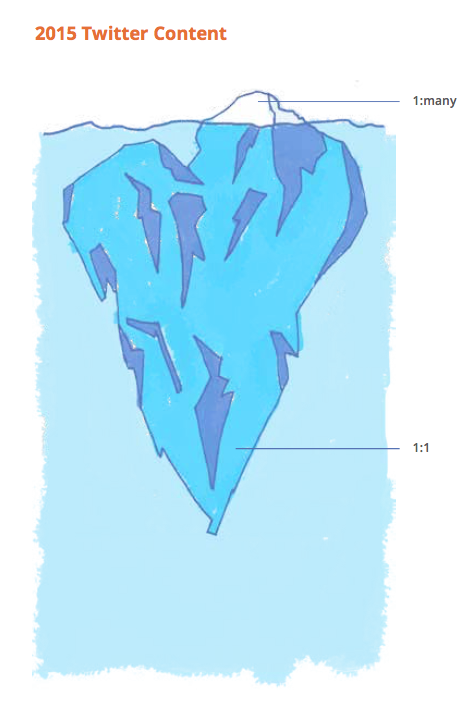The “social iceberg”: The data on 1:1 marketing may surprise you
Columnist Chris Kerns delves into data showing that while the tip of the social media iceberg involves a brand’s entire audience, the bulk of it is made up of one-on-one conversations with individuals.

In the world of social media, marketers are always looking to optimize their tactics to reach the most people in the most powerful ways. We work hard to plan the time, language, imagery and tone/voice of every social communication as we meticulously craft out our calendars with precision.
The examples we often look to for guidance are from campaigns across the industry with a good amount of polish and planning behind them. Award-winning content is usually meant for a brand’s entire audience, to be shouted from a megaphone to all followers and fans.
But there’s another side to social media marketing: the 1:1 conversations that brands are having with individuals every single day. These conversations can’t be planned; they have to be fast, helpful and executed at high volumes.
@jacquelinehadel You're very welcome Jacqueline, it was great to have you with us. Hope to see you again soon, take care! :) -Chloe
— Cathay Pacific (@cathaypacific) March 7, 2016
But we’ve never seen data about much of this 1:1 content that’s being created by brands.
Is the content meant for “an audience of one,” just a fraction of the overall social team’s efforts, or does it deserve more our of attention? How much 1:1 content is really being created by brands, responding to their questions, addressing complaints, or helping them with their day?
As it turns out, more than you might think.
The data
As part of our new Smart Social Report Volume 4 (registration required), we were interested in researching the levels of 1:many vs. 1:1 content being created across a collection of industries.
We collected Twitter data from 20 of the biggest brands in the world. Often, brands have multiple accounts for dedicated customer support channels on Twitter (for example, eBay has both @eBay and @askeBay), so we mined all relevant accounts for these brands to measure the entire social footprint on the social channel.

We ended up with 1.3 million tweets for all of 2015 from 43 Twitter brand accounts from a diverse set of verticals that includes software/internet, electronics, grocers and airlines.
The “social iceberg”
What we found was surprising. Not only was the majority of the 2015 social content created by the brands in our study 1:1, it wasn’t even a contest.

More than 93 percent of social content created by the brands was 1:1, leaving only seven percent as the 1:many content that we all know so well. That’s right, 93 percent of the tweets created were replies or messages directly to single individuals, not meant to be broadcast to the masses, but as individual brand touch points.
@wadesugiyama Wade, thanks so much for reaching out! We love your passion and excitement about innovating to make the impossible, possible!
— GE Vernova (@GEVernova) March 2, 2016
Some of the brands with the highest rates of personal social outreach might surprise you. Ninety-six percent of Samsung’s tweets from 2015 were replies; ninety-six percent of Microsoft’s tweets were to individuals; and Asda saw their 1:1 tweets at 97 percent of their total 2015 Twitter content.

And not only did 1:1 conversations far outnumber 1:many conversations for 2015, the numbers rose steadily every quarter throughout the year.
Social care: industry-by-industry breakdown
We found a slight variance between the industries in our study, but for the most part, the dominance of 1:1 was consistent across brands.

Airlines saw the highest percentage of social customer service content, with 98 percent of their tweets in 2015 being in response to a customer question or issue. The industry with the lowest percentage of 1:1 was software/internet, but even that group saw 89 percent of their content as 1:1.
Conclusions
Marketers are always asking how to take advantage of every opportunity to reach and delight their prospects and customers. All too often, we concentrate more on the efforts that get more attention from the press and industry insiders without stepping back and thinking about our overall marketing strategy, which should include both 1:many and 1:1 approaches.
After seeing the data on how individual social touch points are a growing trend for brands, marketers would be wise to check how their own attention and budgets are allocated.
Ask yourself the following three questions to help figure out if you’re giving 1:1 marketing the attention it deserves:
- Does your budget reflect how you create content? I’m not advocating that budgets should reflect the percentage of 1:1 vs. 1:many, but I’m guessing these numbers will be eye-opening for many marketers who focus more on the content created for their entire follower base. Make sure you’re finding a balance based on your organization’s needs and strategy.
- Does your team embrace the brand voice with their 1:1 communication? Make sure your social customer care team is well-equipped to handle the increasing levels of asks from their social audience. Responses need to be on-brand, in the right tone and voice, and fast.
- Is your social customer care team prepared to surprise and delight your customers? Don’t just stop at answering questions. Try to make the most of these valuable customer touch points with an arsenal of assets (like coupon codes) to make your 1:1 marketing strategy stick, and get those customers talking about your brand in the best way possible.
Contributing authors are invited to create content for MarTech and are chosen for their expertise and contribution to the martech community. Our contributors work under the oversight of the editorial staff and contributions are checked for quality and relevance to our readers. MarTech is owned by Semrush. Contributor was not asked to make any direct or indirect mentions of Semrush. The opinions they express are their own.
Related stories